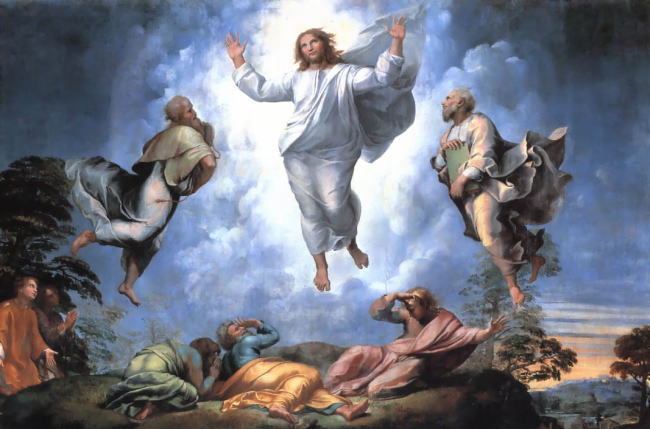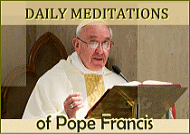Readings: Dn 7: 9-10, 13-14; Ps 97: 1-2, 5-6, 9; 2 Pt 1: 16-19; Mt 17: 1-9
Transfigure us, O Lord!
I’m sure you are familiar with this expression: ‘No pain, no gain; no thorn, no crown; no suffering, no glory!’
Today, we are celebrating the Feast of the Transfiguration. The word ‘transfiguration’ is derived from the Latin word transfigurare for the Greek word metamorphosis which means “change of form and appearance.” Jesus takes Peter, James and John, this special trio within the twelve, up the high mountain of Tabor where the glory of His destiny is revealed to them. It is the glory that belongs to Him as God’s beloved Son. Transfiguration is the foretaste of heaven. In Tagalog it can be called as unang patikim. This is signified by His dazzling white clothes. Peter wants to preserve the moment. He wants to erect tents. He is overwhelmed and terrified by the experience, yet he does not want it to end.
“Twins, a sister and brother were talking to each other in the womb. The little sister said to the little brother, ‘I believe that there is life after birth!’ Her brother protested: ‘No, no, this is all there is. This is a dark and cozy place, and we have nothing else to do but to cling on to the cord that feeds us.’ But the little girl insisted: ‘There must be something more than this dark place, there must be something else where there is light and freedom to move.’ Still she could not convince her twin brother. Then…after some silence, she said hesitantly: ‘I have something else to say, and I am afraid you won’t believe that either, but I think there is a mother!’ Her little brother now became furious: ‘A mother, a mother, what are you talking about? I have never seen a mother and neither have you. Who put that idea in your head? As I told you, this place is all we have so let’s be content.’ The little sister finally said: ‘Don’t you feel this pressure sometimes? Its really unpleasant and sometimes even painful.’ ‘Yes,’ he answered, ‘what’s special about that?’ ‘Well,’ the sister said, ‘I think this pressure is there to get us ready for another place, much more beautiful than this, where we will see our mother face to face! Don’t you think that’s exciting!” (Unfortunately I do not know the source.)
In that story the twin brother did not believe there was anything beyond what he could see and hear and touch while his twin sister believed there was a life beyond what she could see and hear and touch, that there was a mother even though she could not see her. In the Transfiguration, Peter, James and John saw that there was more to Jesus than what they could see and hear and touch, they got a glimpse of the future glory of Jesus’ resurrection. It was an extraordinary privilege.
Today’s gospel tells us of the Transfiguration of Christ, when he took Peter and James and John to a high mountain and there revealed to them his divine glory. This was a foretaste of the glory of his risen body and a sign of the dawning of Christ’s Kingdom. This was true of Jesus’ other miracles, for they were all signs of the Kingdom and manifestations of his power: yet in his other miracles, Jesus’ majesty was veiled in his humanity. At the Transfiguration, the veil is lifted for a moment, and the apostles behold Christ, not in his humiliation but in his splendor as Light from Light and true God from true God. Now for the apostles, the Transfiguration was part of their training, an experience that was meant to lead them to belief in the divinity of Christ and to cling to it, even in the face of his coming Passion and Death.
We know that they were overwhelmed by what they saw: not only was Jesus transfigured before them, so that his face shone like the sun and his clothes were brilliant in their whiteness, but Moses and Elijah also appeared in his company and conversed with Jesus. Why Moses and Elijah? Because Moses represents the Law and Elijah represents the Prophets: that is, they represent God’s revelation to Israel, recorded in the Scriptures. Moses and Elijah also point us to the Resurrection of Christ. Of Elijah, we read in the Second Book of Kings (2 Kg 2.11) that he was taken up to heaven in a whirlwind, with chariots and horses of fire. Of Moses, it was a pious belief among Jews that, shortly after his death, he was also assumed bodily into heaven since, as the Book of Deuteronomy tells us, no man knew the place of his burial (Dt 34.6). The Letter of Jude (Jude 9) in the New Testament seems to allude to this pious belief concerning the assumption of Moses into heaven.
Like Jesus himself, Moses and Elijah, by being taken into heaven, body and soul, had in some way anticipated the general resurrection. And now, these two, Moses and Elijah, appear in Jesus’ company, testifying that Jesus is even greater than they; and the very voice of God speaks out of the cloud, saying: “This is my Son, my Chosen; listen to him” (Lk 28.35).
According to Catholic tradition, the saints of the Old Testament would not yet have had the beatific vision of God since Christ had not yet opened the gates of heaven by his death and resurrection. So the vision of Christ’s glory would be for Moses and Elijah the foretaste of a supreme joy that would soon be theirs: for they had at last seen the Messiah. Why, you may ask, did Peter then suggest building three tents or tabernacles on the mountain? Peter did so because this is what Jews did when they celebrated the Feast of Tabernacles: they would build tents or temporary dwellings or tabernacles in memory of the Israelites’ journey through the wilderness on the way to the Promised Land. Devout Jews believed that when the Messiah would come, this miracle would be renewed, and Israel would again dwell in such tents and the presence of God would be manifest among them once more.
Now it may seem strange that they would be nostalgic about that time in the desert. From a human standpoint, it was a time of great suffering and sorrow: the Israelites were afflicted with hunger and thirst, they were bitten by serpents, they rebelled against God and Moses and were punished for it. And yet, despite all that, the Jews remembered with longing that time when God was so incomparably close to them, when God led them through the desert in the form of a cloud by day and a pillar of fire by night, and when God fed them with manna, the bread from heaven. It was that nearness of God’s presence that was forever burned into Israel’s memory, and which they longed to see once more in the Messiah’s kingdom. And so we see what Peter meant: that the age of the Messiah had come at last, that Christ is the new Moses, and that like the elders who accompanied Moses up to the holy mountain, so the apostles, too, should remain there with Christ. St. Luke says that after Peter had spoken, a cloud overshadowed them. The Greek word for overshadowing is episkiazein; it appears earlier in Luke’s gospel, in the words of the angel Gabriel to Mary: The Holy Spirit will come upon you, and the power of the Most High will overshadow you; therefore the child to be born will be called holy (Lk 1.35).
The divine overshadowing by the Holy Spirit began with Mary at the Annunciation. At the Tranfiguration, we see that this overshadowing by the Spirit now includes the saints of the Old Testament and the apostles of the New Covenant, as well. Peter does not need to build the Lord a tabernacle, a tent: by becoming man in the womb of Mary, the Lord has already overshadowed us and pitched his own tent among us. That is the literal meaning of St. John’s words in the Prologue of his gospel: “And the word became flesh and pitched his tent among us–tabernacled among us–full of grace and truth” (Jn 1.14). We see also that salvation in Christ is not liberation from an evil or illusory body, as many religions have held, but the redemption and sanctification of both body and soul. This integral redemption and sanctification of mankind began with Mary, when she assented to the angel’s message, and it has been fulfilled in Our Lady’s bodily Assumption into Christ’s heavenly glory. In this life, we are still pilgrims and must still bear the Lord’s Cross, knowing that “our commonwealth is in heaven, and from it we await a Savior, the Lord Jesus Christ, who will change our lowly bodies to be like his glorious body, by the power which enables him even to subject all things to himself” (Phil. 3.20-21). St. Benedict in the Prologue of his Rule tells us that if we wish to dwell in the tent of this kingdom, we will never arrive unless we run there by doing good deeds. But let us ask with the Prophet (Ps. 15.1), Who will dwell in your tent, O Lord; who will find rest on your holy mountain? (Rule of St. Benedict, Prol. 22-24).
After this question, brothers, let us listen well to what the Lord says in reply, for he shows us the way to his tent… Let us open our eyes to the light that comes from God (the deific light), and our ears to the voice from heaven that every day calls out this charge: If you hear his voice today, do not harden your hearts (Ps. 95.8). Still today, the voice speaks from the luminous cloud, telling us, “This is my beloved Son; listen to him” (Lk 28.35). At the Transfiguration, we catch a glimpse of the glory of Christ and of our own destiny: what St. Paul sums up simply as “Christ in you, the hope of glory” (Col. 1.27)
I have witnessed people transfigured, not in terms of physical transformation but in terms of spiritual and moral transformation. I have a friend, he is a priest now. Before he entered the seminary, he was a drug addict, and a member of a gang. But when he entered the seminary after he attended an intense spiritual renewal, some changes happened about him and now he is a priest of good standing and one of the good priests in his diocese where he was incardinated. Yes, even if we are not on Mt. Tabor, transfiguration happens.
Fr. Gaspar Fernandes, OFM Cap.


